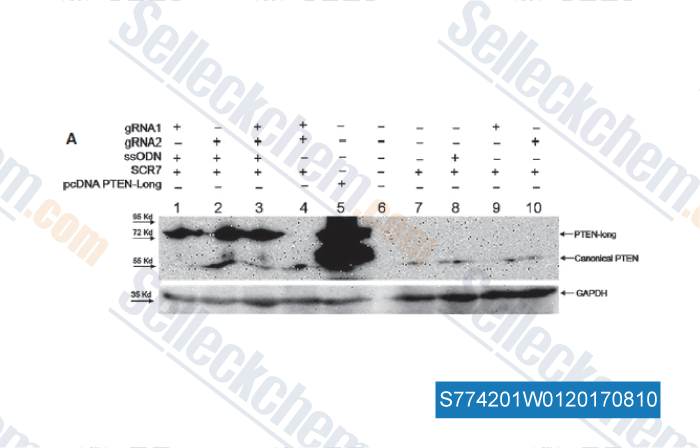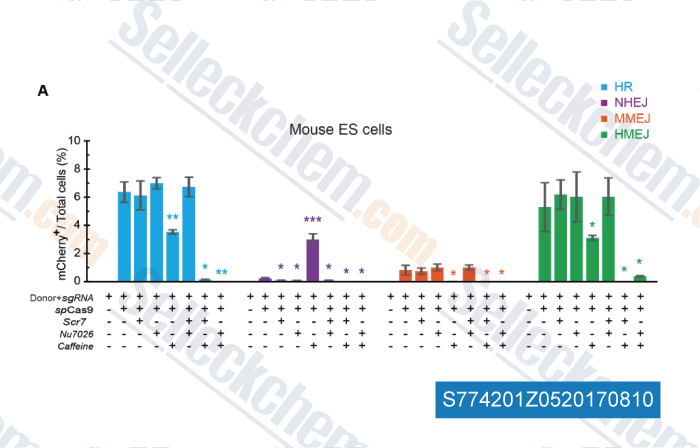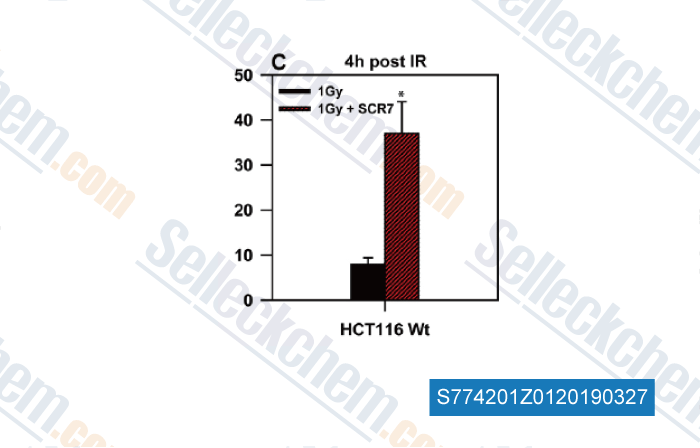|
Toll Free: (877) 796-6397 -- USA and Canada only -- |
Fax: +1-832-582-8590 Orders: +1-832-582-8158 |
Tech Support: +1-832-582-8158 Ext:3 Please provide your Order Number in the email. |
Technical Data
| Formula | C18H12N4OS |
|||
| Molecular Weight | 332.38 | CAS No. | 14892-97-8 | |
| Solubility (25°C)* | In vitro | DMSO | 66 mg/mL (198.56 mM) | |
| Ethanol | 23 mg/mL (69.19 mM) | |||
| Water | Insoluble | |||
|
* <1 mg/ml means slightly soluble or insoluble. * Please note that Selleck tests the solubility of all compounds in-house, and the actual solubility may differ slightly from published values. This is normal and is due to slight batch-to-batch variations. * Room temperature shipping (Stability testing shows this product can be shipped without any cooling measures.) |
||||
Preparing Stock Solutions
Biological Activity
| Description | SCR7 is a specific DNA Ligase IV inhibitor, which blocks nonhomologous end-joining (NHEJ). It increases the efficiency of HDR-mediated genome editing up to 19-fold using CRISPR/Cas9 in mammalian cells and mouse embryos. | |
|---|---|---|
| Targets |
|
|
| In vitro | SCR7 effectively inhibits the formation of multimers at 200 μM and above. SCR7 successfully inhibits cell proliferation of MCF7, A549, HeLa, T47D, A2780, HT1080, and Nalm6 with IC50 of 40, 34, 44, 8.5, 120, 10, and 50 μM, respectively.[1] SCR7 suppresses the NHEJ repair of CRISPR-Cas9-induced DSBs.[2]SCR7 increases the efficiency of HDR-mediated genome editing up to 19-fold using CRISPR/Cas9 in mammalian cells and mouse embryos[3]. |
|
| In vivo | SCR7 treatment (10 mg/kg, i.m.) significantly reduces breast adenocarcinoma-induced tumor, and exhibits 4-fold increase in lifespan compared with control group. However, in Swiss albino mice with Dalton’s lymphoma tumor model, SCR7 (20 mg/kg, i.p.) exhibits neither tumor regression nor increase in lifespan. In BALB/c mice, SCR7 (20 mg/kg, i.p.) significantly enhances the cytotoxic effects of radiation, VP-16213 and 3-Aminobenzamide on tumor derived from Dalton’s lymphoma (DLA) cells.[1] |
Protocol (from reference)
| Kinase Assay: |
|
|---|---|
| Cell Assay: |
|
| Animal Study: |
|
References
|
Customer Product Validation

-
, , J Cell Mol Med, 2017, 21(12):3337-3346

-
Data from [Data independently produced by , , Cell Res, 2017, 27(6):801-814]

-
Data from [Data independently produced by , , Mutat Res Genet Toxicol Environ Mutagen, 2015, 793:2-8]
Selleck's SCR7 has been cited by 42 publications
| Identifying key underlying regulatory networks and predicting targets of orphan C/D box SNORD116 snoRNAs in Prader-Willi syndrome [ Nucleic Acids Res, 2024, 52(22):13757-13774] | PubMed: 39575480 |
| Low-dose ionizing radiation-induced RET/PTC1 rearrangement via the non-homologous end joining pathway to drive thyroid cancer [ MedComm (2020), 2024, 5(8):e690] | PubMed: 39135916 |
| The fragile X locus is prone to spontaneous DNA damage that is preferentially repaired by nonhomologous end-joining to preserve genome integrity [ iScience, 2024, 27(2):108814] | PubMed: 38303711 |
| Simultaneous inhibition of DNA-PK and Polϴ improves integration efficiency and precision of genome editing [ Nat Commun, 2023, 14(1):4761] | PubMed: 37580318 |
| Simultaneous inhibition of DNA-PK and Polϴ improves integration efficiency and precision of genome editing [ Nat Commun, 2023, 14(1):4761] | PubMed: 37580318 |
| MDM2 antagonists promote CRISPR/Cas9-mediated precise genome editing in sheep primary cells [ Mol Ther Nucleic Acids, 2023, 31:309-323] | PubMed: 36726409 |
| A monoclonal Trd chain supports the development of the complete set of functional γδ T cell lineages [ Cell Rep, 2023, 42(3):112253] | PubMed: 36920908 |
| Selective utilization of non-homologous end-joining and homologous recombination for DNA repair during meiotic maturation in mouse oocytes [ Cell Prolif, 2023, 56(4):e13384] | PubMed: 36564861 |
| In situ correction of various β-thalassemia mutations in human hematopoietic stem cells [ Front Cell Dev Biol, 2023, 11:1276890] | PubMed: 38333188 |
| Increase of c-FOS promoter transcriptional activity by the dual leucine zipper kinase [ Naunyn Schmiedebergs Arch Pharmacol, 2023, none] | PubMed: 36700987 |
RETURN POLICY
Selleck Chemical’s Unconditional Return Policy ensures a smooth online shopping experience for our customers. If you are in any way unsatisfied with your purchase, you may return any item(s) within 7 days of receiving it. In the event of product quality issues, either protocol related or product related problems, you may return any item(s) within 365 days from the original purchase date. Please follow the instructions below when returning products.
SHIPPING AND STORAGE
Selleck products are transported at room temperature. If you receive the product at room temperature, please rest assured, the Selleck Quality Inspection Department has conducted experiments to verify that the normal temperature placement of one month will not affect the biological activity of powder products. After collecting, please store the product according to the requirements described in the datasheet. Most Selleck products are stable under the recommended conditions.
NOT FOR HUMAN, VETERINARY DIAGNOSTIC OR THERAPEUTIC USE.
